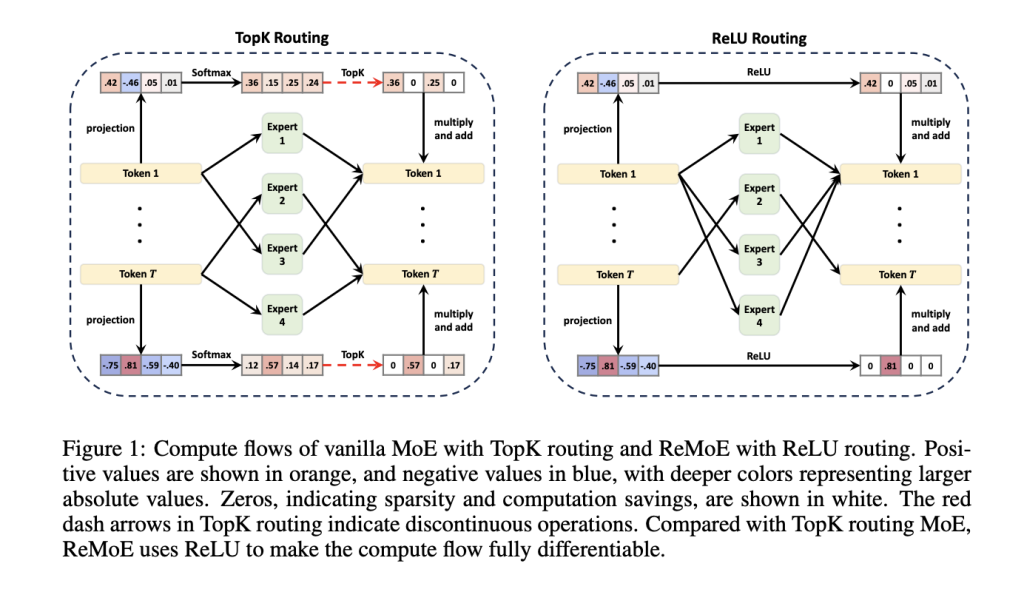

The development of Transformer models has significantly advanced artificial intelligence, delivering remarkable performance across diverse tasks. However, these advancements often come with steep computational requirements, presenting challenges in scalability and efficiency. Sparsely activated Mixture-of-Experts (MoE) architectures provide a promising solution, enabling increased model capacity without proportional computational costs. Yet, traditional TopK+Softmax routing in MoE models faces notable limitations. The discrete and non-differentiable nature of TopK routing hampers scalability and optimization, while ensuring balanced expert utilization remains a persistent issue, leading to inefficiencies and suboptimal performance.
Researchers at Tsinghua University have proposed ReMoE (ReLU-based Mixture-of-Experts), a new architecture that addresses these limitations. ReMoE replaces the conventional TopK+Softmax routing with a ReLU-based mechanism, enabling a fully differentiable routing process. This design simplifies the architecture and seamlessly integrates with existing MoE systems.
ReMoE employs ReLU activation functions to dynamically determine the active state of experts. Unlike TopK routing, which activates only the top-k experts based on a discrete probability distribution, ReLU routing transitions smoothly between active and inactive states. The sparsity of activated experts is controlled using adaptive L1 regularization, ensuring efficient computation while maintaining high performance. This differentiable design also allows for dynamic allocation of resources across tokens and layers, adapting to the complexity of individual inputs.
Technical Details and Benefits
ReMoE’s innovation lies in its routing mechanism. By replacing the discontinuous TopK operation with a continuous ReLU-based approach, ReMoE eliminates abrupt changes in expert activation, ensuring smoother gradient updates and improved stability during training. Additionally, ReMoE’s dynamic routing mechanism allows for adjusting the number of active experts based on token complexity, promoting efficient resource utilization.
To address imbalances where some experts might remain underutilized, ReMoE incorporates an adaptive load-balancing strategy into its L1 regularization. This refinement ensures a fairer distribution of token assignments across experts, enhancing the model’s capacity and overall performance. The architecture’s scalability is evident in its ability to handle a larger number of experts and finer levels of granularity compared to traditional MoE models.
Performance Insights and Experimental Results
Extensive experiments demonstrate that ReMoE consistently outperforms conventional MoE architectures. The researchers tested ReMoE using the LLaMA architecture, training models of varying sizes (182M to 978M parameters) with different numbers of experts (4 to 128). Key findings include:
- Improved Performance: ReMoE achieves better validation loss and downstream task accuracy compared to TopK-routed MoE models.
- Scalability: The performance gap between ReMoE and conventional MoE widens with an increasing number of experts, showcasing ReMoE’s scalability.
- Efficient Resource Allocation: ReMoE dynamically allocates computational resources to more complex tokens, optimizing performance while maintaining efficiency.
For example, on downstream tasks such as ARC, BoolQ, and LAMBADA, ReMoE demonstrated measurable accuracy improvements over both dense and TopK-routed MoE models. Training and inference throughput analyses revealed that ReMoE’s differentiable design introduces minimal computational overhead, making it suitable for practical applications.
Conclusion
ReMoE marks a thoughtful advancement in Mixture-of-Experts architectures by addressing the limitations of TopK+Softmax routing. The ReLU-based routing mechanism, combined with adaptive regularization techniques, ensures that ReMoE is both efficient and adaptable. This innovation highlights the potential of revisiting foundational design choices to achieve better scalability and performance. By offering a practical and resource-conscious approach, ReMoE provides a valuable tool for advancing AI systems to meet growing computational demands.
Check out the Paper and GitHub Page. All credit for this research goes to the researchers of this project. Also, don’t forget to follow us on Twitter and join our Telegram Channel and LinkedIn Group. Don’t Forget to join our 60k+ ML SubReddit.
The post Researchers from Tsinghua University Propose ReMoE: A Fully Differentiable MoE Architecture with ReLU Routing appeared first on MarkTechPost.
Source: Read MoreÂ



 Trending: LG AI Research Releases EXAONE 3.5: Three Open-Source Bilingual Frontier AI-level Models Delivering Unmatched Instruction Following and Long Context Understanding for Global Leadership in Generative AI Excellence….
Trending: LG AI Research Releases EXAONE 3.5: Three Open-Source Bilingual Frontier AI-level Models Delivering Unmatched Instruction Following and Long Context Understanding for Global Leadership in Generative AI Excellence….